More than you ever wanted to know about Baltic International Air Show 2024
Thirteen thousand people descended on Liepāja Airport for the Baltic International Air Show on the weekend of June 15th. One of them was me, clutching a VIP ticket that I’d been offered just the week before.
I expected an intimate airshow at a small airfield but the Baltic International Air Show was clearly a major event. I thought I’d done well to arrive early and found that the cars were already backed up from the parking lot to the main road.
Liepāja started as a military aerodrome, controlled by the Soviets and then the Germans and then the Soviets again, until 1960 when it became a civil airport, offering six flights a day to Riga and other cities in the USSR.
Nowadays, it’s a bit quieter. When I checked the arrivals board, two flights were listed: single-engine aircraft which had taken off from Liepāja an hour before. airBaltic offer flights between Tallinn and Liepāja in July and August, which was a little too late for me. I wished I could attend as a fly-in guest; the Piper Saratoga would have looked a treat on the visitor’s apron. Liepāja airport lies near the coast, easy to spot with the 2,000 metre runway (6,500 feet) perpendicular to the coast and leading up to the coast of the lake. As I didn’t have a plane, I travelled by bus, which is normally a ten-hour journey. For me, it took fourteen hours, as I had to rush back home after the first leg of the journey to pick up my passport, but that’s not Liepāja’s fault.
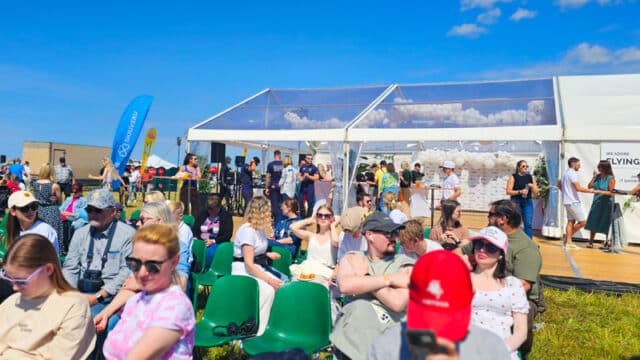
The VIP area sat right on the taxiway, giving us an unobstructed view of pilots in their cockpits as they taxied out and took off. I took fantastic photos with just my phone, although the real photographers, armed with high-end cameras, tripods, and zoom lenses the size of jet intakes, undoubtedly captured the best photographs.
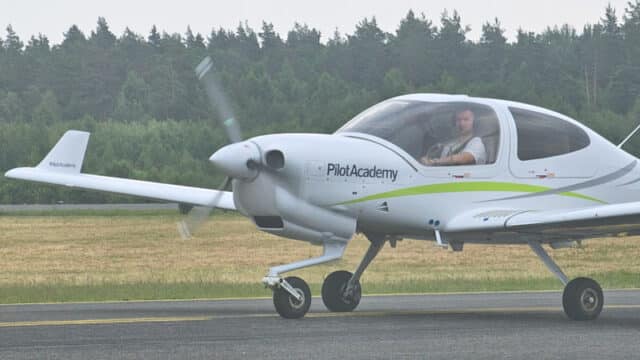
Liepāja’s main traffic is trainee pilots. The airfield is one of two bases for the airBaltic Training Pilot Academy (the other is in Riga). Their primary trainer, the Diamond DA40 NG, is a rugged and versatile diesel-powered aircraft with mild-mannered handling characteristics and intentionally wide landing gear, which makes it a favourite with flying schools.
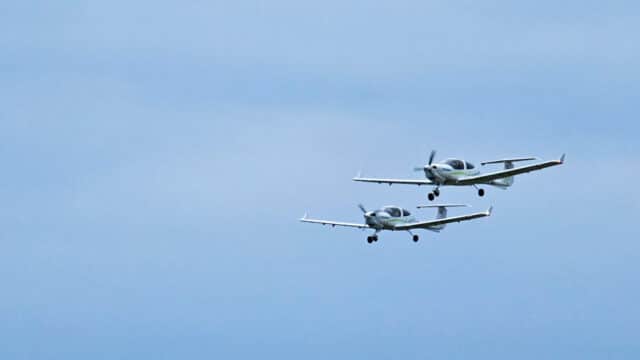
One DA40 was set up as a static display with pilots, instructors and HR staff eager to talk to anyone who paused to take a look. The Academy opened the show with three of the Diamond DA40s flying in formation above the crowds. Although not the most dramatic of the day’s displays, it did tempt me into asking for more details from the academy and whether they had any options for getting my license back into date! Sadly, they didn’t seem interested in training me for an eventual left seat in their A220 fleet.
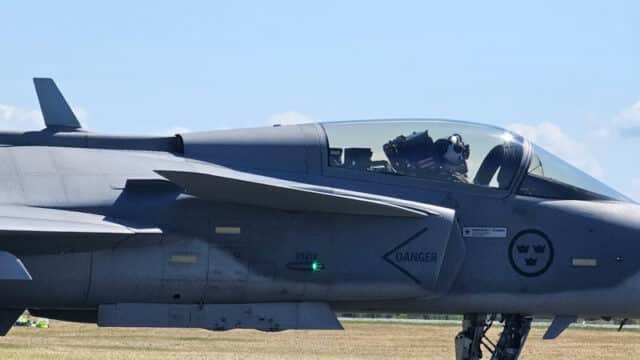
The next aircraft to pass by the taxiway was rather more swoonworthy: The Swedish Air Force Saab JAS39 Gripen.
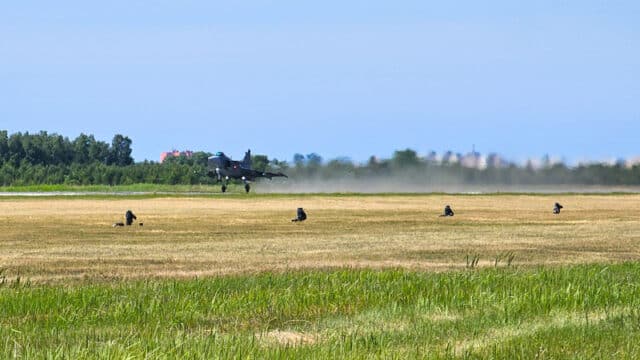
The Gripen JAS39 is a single-engine multi-role warplane manufactured by Saab based on Swedish development studies for a multirole aircraft that could fill their needs as a fighter, attack and reconnaissance aircraft (jakt-, attack-, och spaningsflygplan: JAS). Sweden has initiated another series of warplane studies to consider the next steps but plans to continue with the Gripen E until 2060.
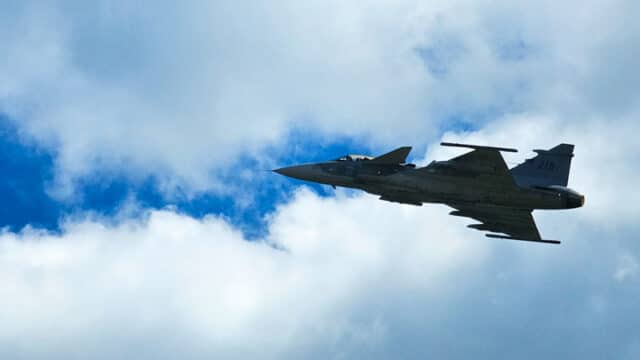
The Swedish Air Force is a great demonstration of the importance of a safety culture that permeates the entire organisation. Over 600 Swedish fighter pilots were killed in crashes during peacetime exercises between 1945 and 1991. To put that into context, this Expressen article from 2013 (in Swedish) says that in the 1960s, Sweden had a six times higher mortality rate per 100,000 compared to the United States. The higher-ups took a step back to analyse the issue and concluded that the pilots were not given enough training and the manoeuvres they were asked to do were too risky. The Air Force began to spend more time on training which quickly led to a clear decline in the mortality rate.
Today, there has not been a single fatal accident since 1996, which is when the Saab JAS 39 Gripen entered service. In fact, I found only one fatal Gripen crash during the same time period: in 2017, a Royal Thai Air Force JAS 39C Gripen crashed during an airshow, killing the pilot.

The Swedish Air Force did manage to write off a Gripen in 1999, when the aircraft stalled after passing another aircraft’s vortex, and, from the looks of it, they trashed another one in 2018 which was involved in a bird strike on landing. But the important thing is that, in both instances, the pilot ejected safely.
The solo display showed off the Gripen’s agility and speed, delighting us with steep climbs, upside down fly-bys and bright flares in the summer sun.

The AutoGyro MTOsport flown by pilot Gintautas Griauzdė made for quite a contrast to the warbird. The surprisingly versatile gyrocopter, produced in Germany and the UK, has two seats with a max take-off weight of 650kg. This didn’t seem that impressive when the gyrocopter was parked next to the Airbus military transport aircraft, but it means the copter can take two passengers plus luggage, which would be quite useful with its a 3.5 hour range on the 96 litre (25 US gallons) fuel tank. The specs say that it needs 250 metres (820 feet) take off distance including obstacle clearance, but on the runway, Griauzdė seemed to get away with almost half of that.
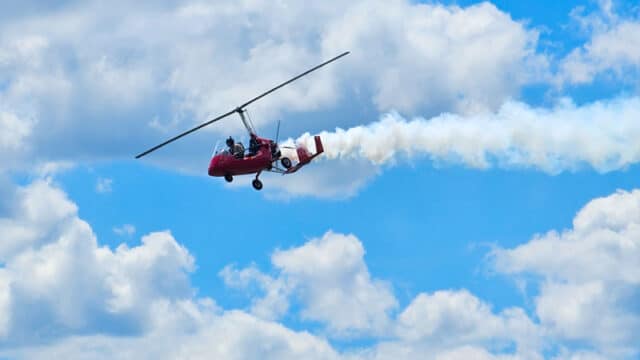
The announcements were mostly in Latvian; however, one of the commentators made a point of adding English commentary in the pauses. I introduced myself on the first day to let her know that her efforts were appreciated. On the second day, she stopped me to ask if I had noticed the increase in the English commentary, as she was wanted to make sure we felt included.

We had repeated displays of pilot Griauzdė flying the gyrocopter interspersed between the bigger aircraft. It was easily able to weave around the larger aircraft and return to the runway to launch for another set of spins. During one of the displays, the commentator told us that the gyrocopters were a good and cheap way to get into flying, so I took a quick look. Pricing for the MTOsport starts at €80k, for which you could easily pick up a used Cessna 170. Still, I’d happily accept a gyrocopter if it landed in my garden.
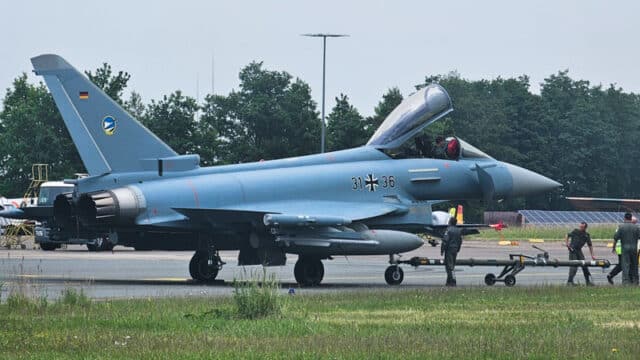
The Taktisches Luftwaffengeschwader 31, or Tactical Air Force Wing 31 is the fighter/bomber wing of the German Air Force and exclusively flies the Eurofighter EF 2000, a two-engine one-seater fighter jet.
The Eurofighter at the airfield, 31-36, is part of a German detachment based in Lielvarde, near Riga, Latvia as a part of the Baltic Air Policing mission. I have previously seen the German Eurofighters flying out of Ämari Military Air Base which is just 20 kilometres from my home in Estonia… but until now, I’d never been close enough to read the registrations! Ämari is currently getting its runway renovated, so the NATO aircraft which are usually in Estonia are based in Latvia this summer.
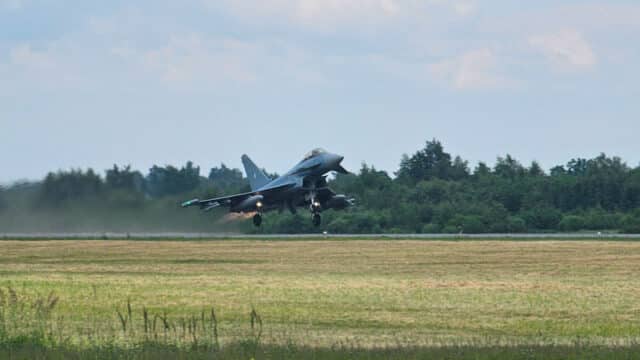
I’ve noticed before that in Germany, the Eurofighter is referred to as the EF2000 as opposed to the Typhoon. It was officially referred to as the EF 2000 from 1992 to 1998, when the partner nations (UK, Germany, Italy and Spain) apparently agreed to change the name to the Eurofighter Typhoon, a wind-based name which was the same in all four languages and the imagery of a storm that could strike swiftly and with great force.

The RAF formally adopted the name in 2002 and it is used in at least some documentation in Italy and Spain, but Germany has never used the name officially, staying with the EF 2000. Apparently, most of the German pilots call the aircraft Eufi for short, avoiding the name completely.

One of the highlights of the air show was the Air Masters Cup. I wasn’t able to find much information about the aerobatic competition, which has started this year with two challenges for pilots to collect points in hopes of becoming the Air Masters Cup Winner. This weekend was the freestyle flight competition, with the final challenge in Kaunus in July. We had three contenders for the cup, who were tasked with flying a freestyle programme lasting from 3½ to 4 minutes.
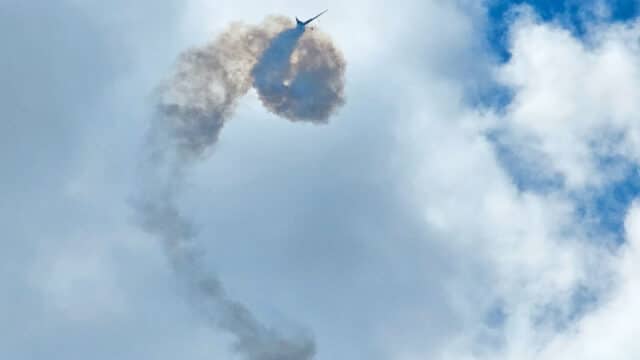
The first up was Igoris Lobanovas from Vilnius. A member of the Iron Wolf Aerobatics team from Lithuania, Lobanovas is also a B738 captain with Ryanair (Buzz). For aerobatics, he flies the XtremeAir Sbach 342, better known as the XA-42. We were lucky to see him again at the end of the day as a part of the pyrotechnics display.
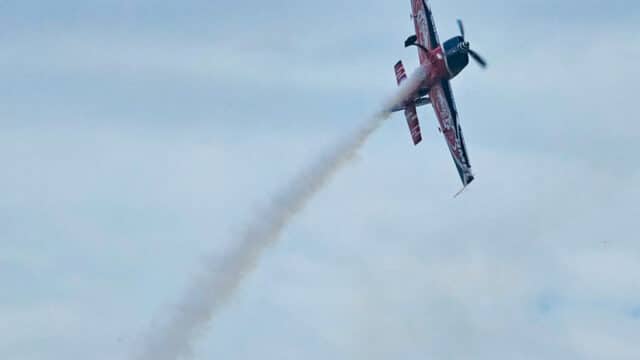
Next was Mélanie Astles, a French aerobatic pilot in an Extra 330. She the first woman to compete in the Red Bull Air Race Challenger Cup. In Cannes, Astles actually set the fastest time; however, in the process, she also exceeded the max 10G allowed. The two-second penalty was enough to drop her into 4th place.
Her display was fast and furious. Amusingly, she continued to fly a few extra loops for the cheering crowd after her time had finished, leading the next contender to enter the runway and line up while she was still spinning overhead.
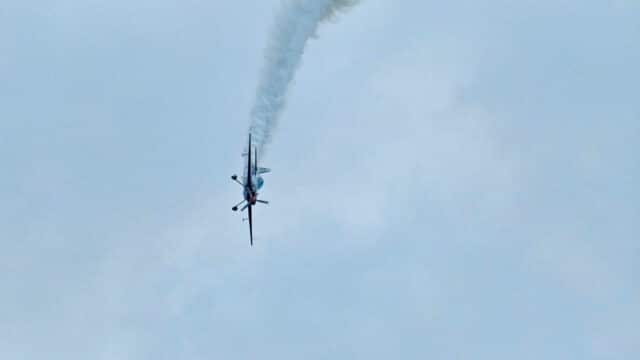
The third contender was Aarron Deliu from Australia. Deliu’s aircraft of choice was the same as Astles, an Extra 330. His display was most obviously synchronised to music which added another level of entertainment to the spins and loops. At one point, I was convinced he was going to fall out of the sky. Another very experienced aerobatic pilot, Deliu won the Sky Grand Prix champion in 2023. Unfortunately, on the Saturday his display was slightly overshadowed by an Airbus A400M rumbling past during his qualifier.
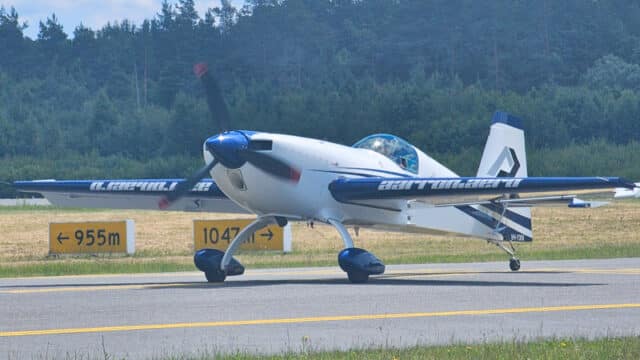
All three put on a great show and had the audience entranced (other than the brief A400M distraction). I don’t know anything about aerobatic scoring but it seems like it was a close thing. Deliu scored the best with eight points, Astles scored seven and Lobanovas had six. The final challenge is at the Kaunas Aviation Festival on the 27th of July, where the Air Masters Cup winner for 2024 will be named!
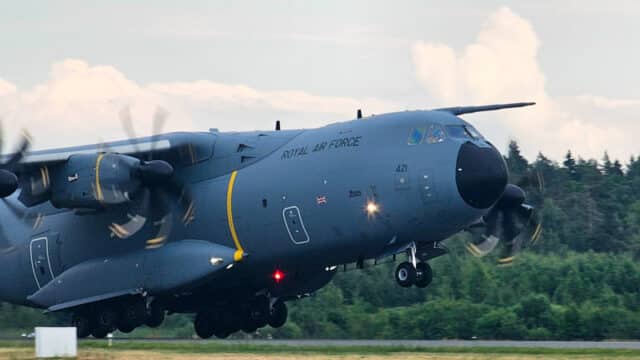
Last year, the British Royal Air Force officially retired the Lockheed C-130 Hercules as their military transport aircraft in favour of the Airbus A400M (the M simply denotes that it is a military aircraft). The four-engine turboprop has more capacity, a longer range and can land in shorter distances. As the behemoth rumbled down the taxiway, everyone stopped watching the latest Air Masters Cup spinning through the air to turn and stare. The commentator became a bit flustered at the interruption as the four turboprop engines drowned her out, but not before we heard her referring to the “Airbus Hercules”. The Airbus A400M was officially named Atlas at RIAT 2012, after the Greek Titan sentenced to bear the weight of the heavens for eternity.
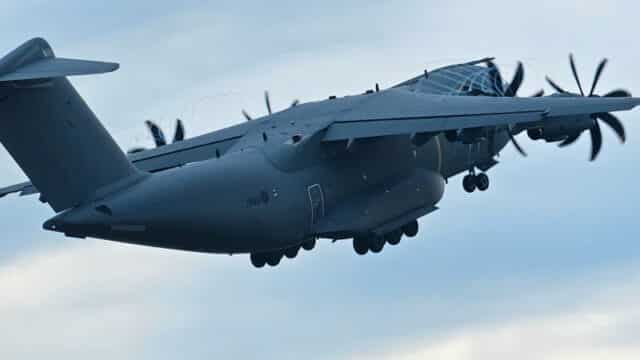
This Atlas, holding the RAF Falcons in its belly, slowly made its way to the far end, apparently wanting every centimetre of the runway. It didn’t need it, rising up into the air like the hippo in Disney’s Fantasia. Only once it had disappeared into the clouds did our attention return to the aerobatics happening directly over our heads.
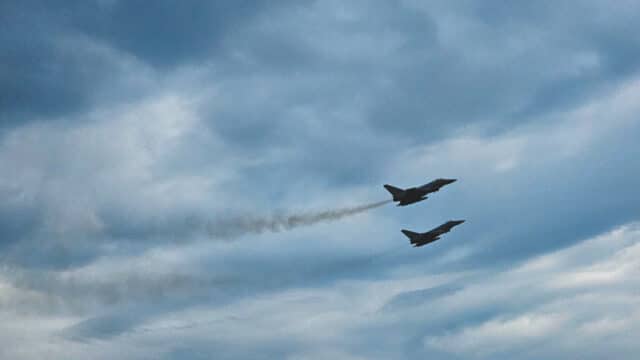
(So: I’m not saying I’m good enough to spot a Eurofighter from an F-16 unless I’m staring at its ass, but I should have noticed from the photographs before posting. Anyway, it seems that I didn’t get a single good shot of the F-16s as they flew past and it was the Eurofighters flying in from the Latvian base who did multiple low passes. Sorry for the confusion!)
The XA-42 had barely cleared the runway when two F-16s appeared with a sudden roar, again causing the commentator to exclaim with surprise. Once she had recovered, she explained that they were from the Portuguese Air Force. This pair are stationed in Latvia along with the Spanish Air Force as a part of a NATO air policing mission. They have already intercepted their first Russian aircraft.
The F-16s pair of Eurofighters circled for multiple low passes over the runway. I was unreasonably amused by the woman next to me, who was taken completely by surprise every single time, closing her eyes and covering her ears with her hands just a second too late. The rest of us were suitably impressed by the agility of the General Dynamics F-16Eurofighters. Meanwhile, the F-16s, which were long gone by now, were the first production fighter aircraft which was intentionally designed to be aerodynamically unstable in order to reduce drag and improve manoeuvrability. The F-16’s first flight was 50 years ago, although whether you count it as January or February might vary: an unplanned six-minute flight took place as the pilot attempted to recover from a stabilator scrape during a high-speed taxi test.
Officially known as the F-16 Fighting Falcon, the F-16 is still often referred to as the Viper, as it resembles the Colonial Viper starfighter from the original Battlestar Galactica, which is yes, also almost fifty years old.
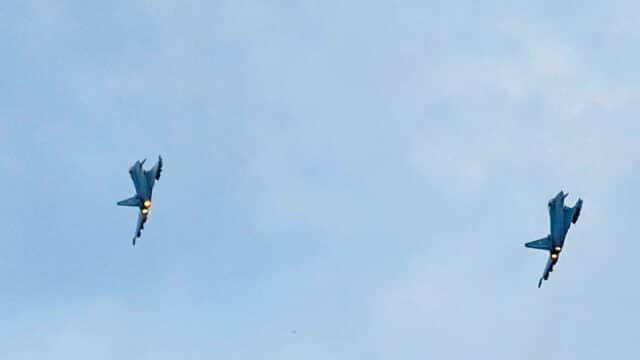
One bit of F-16 trivia I’ve always found fascinating is that, as a fly-by-wire aircraft, the side stick controller doesn’t need to move at all. However, the first pilots struggled with exerting the right amount of control and repeatedly over-rotated when taking off. The control stick was redesigned to allow for a small amount of movement which made it much simpler to use and avoided the too-steep climbs from the runway.
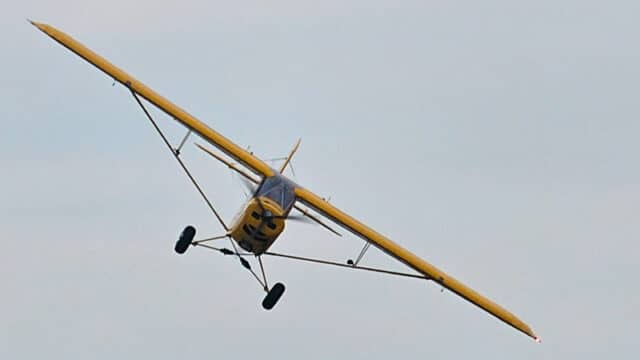
Next up on the runway was a bright yellow Piper J-3F-60 Cub with a registration of LY-CUB. I couldn’t find the details of this particular Cub–the Lithuanian registration site is not up-to-date– but as the J-3 was built between 1938 and 1947, it’s likely to have had an illustrious history. A blue mini-van followed the Cub onto the runway. The Piper Cub is known for its short field landings but today’s stunt was a step higher in difficulty — the pilot, who flies A320s for airBaltic, planned to land the Cub on the top of the moving van. The pilot and the driver were inspired by videos on YouTube: I found three other versions of the stunt online by pilots in the US, Australia and South Africa, but this seems to be the first attempt in Europe. I suspect more detail was given in Latvian; unfortunately the English-language commentary didn’t include any further information on the two men or the minivan itself (and foolishly, I didn’t think to watch for a license plate).
The spectacle requires excellent piloting skills, of course: the Cub needs to line up exactly with the van and nothing but an utterly flawless landing will do. But it also requires immense skill from the driver: the van must accelerate into position quickly and then perfectly hold a specific speed until the front wheel of the Cub has touched down, at which point the van needs to carefully decelerate so that the tail of the Cub slowly drops.

I found this article about another pilot attempting the stunt on a 22-foot platform installed on the top of a pickup truck: Landing on World’s Shortest Runway: dumb things that I’ve done. The article does a lot to put the stunt into context.
As we climbed to altitude, I could see Jim positioning the truck on the runway numbers. He wouldn’t start rolling until I was already on final and waggling my wings. Then he would accelerate to about 48 mph and hold it, probably praying I wouldn’t get sucked into the downwash of the truck and centerpunch him in the rear or fall off the front and get run over. At that point we were having the same thoughts.
As the truck’s speed stabilized. I began to get some feel of the spatial relationships and found myself jockeying the throttle to keep closing the distance, while at the same time trying to fly down to a spot several feet above the truck. A bulb went off in my mind, “Hey, I’m actually doing it!” Easy, easy, a little more throttle, whoa, not too much. here it comes. Then, I was looking down out of the open door of the Cub at the top of the platform. It was so close I could almost throw up on it, and the thought occurred to me.
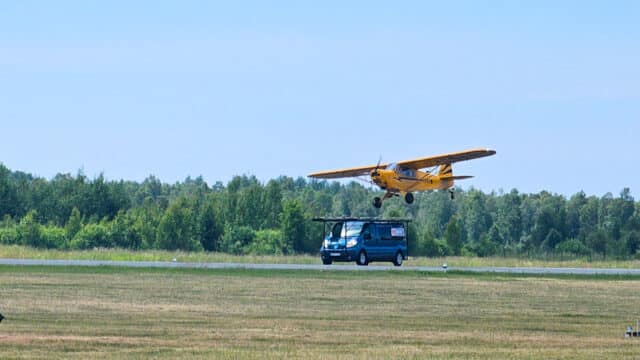
Here at Liepāja, the pilot’s job was further complicated by an unexpected crosswind. Three times, the pilot threw away the attempt with the Cub pulling away at the last minute, but his failures just added to the audience’s respect for how difficult the stunt was.
On the fourth attempt, everyone leaned forward instinctively and the response when the Cub successfully touched down was momentous. The wild cheering continued as the van drove past with the Cub perched on top, both pilot and driver waving to the raucous applause.
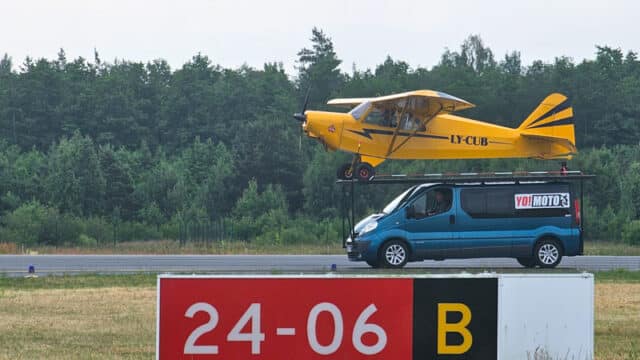
As they returned to the apron, I’m sure I wasn’t the only one wondering “yes, but now how are you going to get the plane down again?” Sure enough, a moment later, the van drove out back out onto the runway. As it picked up speed, the Cub seemed almost to tense up, ready for departure. The driver and pilot once again worked together perfectly and the Cub easily climbed away.
I enjoyed the entire airshow but you can maybe tell that this stunt, which felt straight from the barnstormer era of aviation, was my favourite.
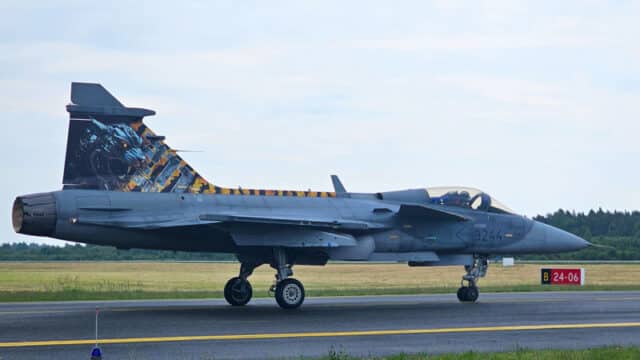
The Czech Air Force also brought a JAS39 Gripen, aircraft 9244 with fantastic tiger stylisation on the back half. The Czech have leased 14 Gripen from Saab for almost twenty years. Those fourteen jets (twelve single-seat and two twin-seat) comprise the 211th Tactical Unit, based at the 21st Tactical Air Force Base in Čáslav, in the Czech Republic.
In 2020, Saab announced that the Czech Gripen fighters had reached 30,000 flight hours over 15 years of operating the Gripen. This wasn’t their first visit to the Baltics; in 2022, the Gripen fighters were deployed in Lithuania for six months as a part of Baltic Air Policing, the NATO air defence mission securing Baltic air space.
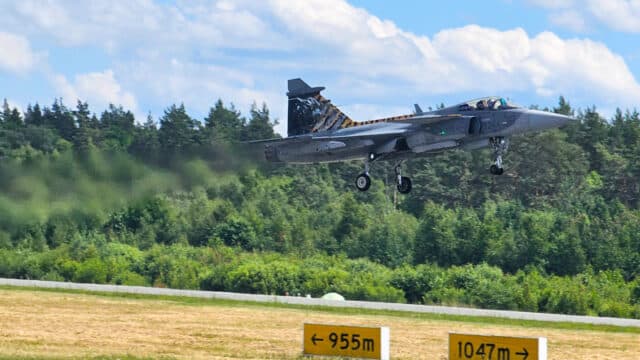
Czech Gripen pilots must first have at least 300 hours on the L-159 ALCA, which they had also brought to the airshow as a static display. Then they undergo training with the Swedish Air Force before returning to Čáslav for a 12-month conversion to the JAS-39C.

The pilot in the Gripen is Captain Ondřej Španko, the 5th Czech Air Force Gripen display pilot. He says that performing in the Gripen is different to other aircraft. The Gripen allows him to perform dynamic manoeuvres which are unthinkable on a stable aircraft with straight wings. The solo performance reaches overloads from -3 to +9G at speeds ranging from 200-1,00 km/h.
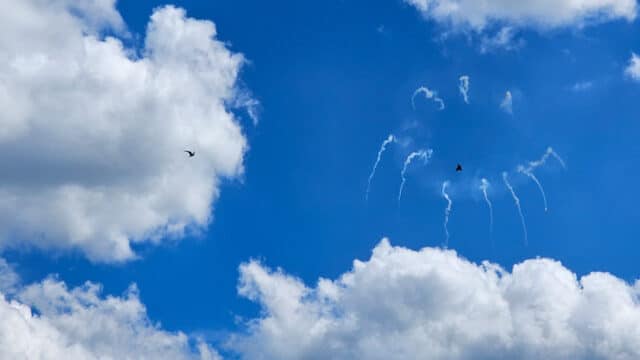
While I was looking up Saab JAS39 Gripen accidents, I found this one from 2006, when a Czech Air Force Gripen accidentally fired on a Learjet 35 while taking part in a live fire exercise in northern Sweden. Oops?
…the Czech pilots mistakenly targeted a reserve target close to the towing plane instead of the intended target 600 meters behind it. After several “dry runs”, live firing commenced, and the first pilot fired on the reserve target. Several rounds hit it, and were calculated to have passed within 10 meters of the Learjet. After this the Czech pilots discovered the actual target they were supposed to fire on, and proceeded to attack it instead. The crew of the Learjet did not notice anything out of the ordinary besides hearing the sound of the cannon, without making the connection that they had been fired upon. The incident was discovered after landing.
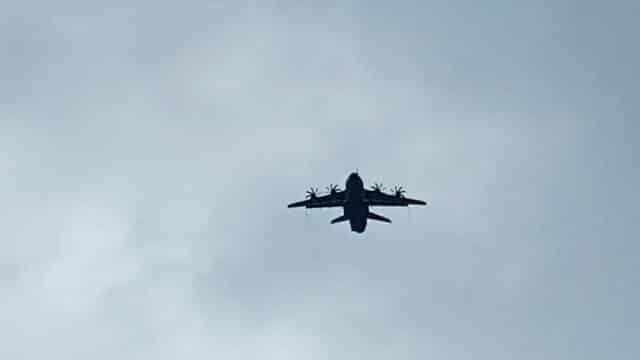
“Look up!”
Our commentator had handed the microphone to Flight Lieutenant Vicky Sweeting of the RAF Falcons. The Airbus A400M Atlas was just coming back into view at 7,000 feet while the Ground Crew set up on the grass in front of us, with bright targets and a smoke machine to ensure the parachuters knew where to land and which way the wind was blowing.

As the A400 continued towards the airfield, we saw the RAF Falcons free-falling from the aircraft, dropping to 5,000 feet before deploying their parachutes.
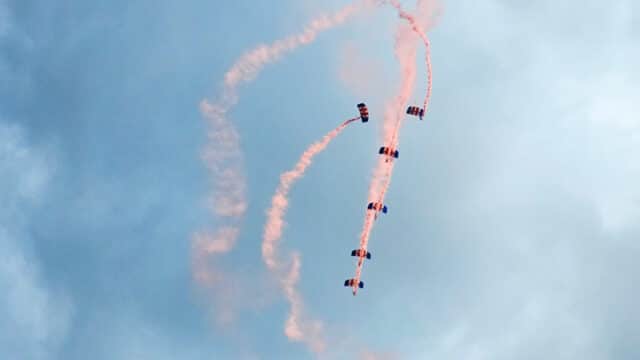
We craned our necks to watch as the RAF commentator explained that the parachute team would start by entering the snake formation, ensuring that they knew their position relative to the others, before stepping through the routine: the carousel, the heart formation and the sabre chase.
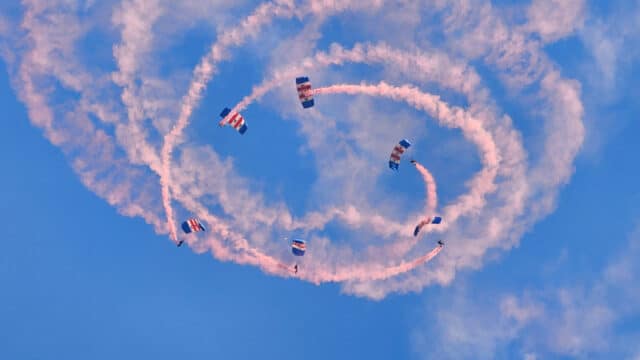
The carousel, which seems to have been the most photographed stunt of the airshow, they flew apart and circled in opposite directions above us, so agile it was hard to believe they were falling, not flying.
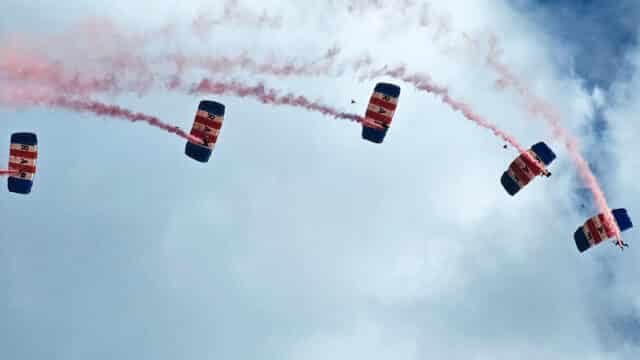
The commentator said that as they crossed, they were flying past each other at forty-five miles per hour.
Has the RAF really not gone metric yet?
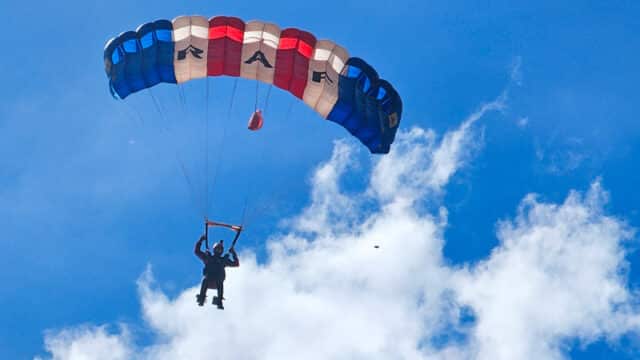
The parachuters spend three years on the team as preparation for offering high altitude training for special forces, doing most of their training in California. As they landed before us, the canopies tumbled to the ground into piles of red white and blue fabric.
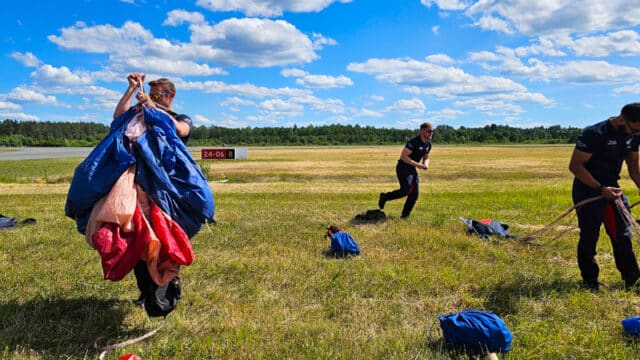
Each team member then carefully re-packed their parachutes, which took about ten minutes — not that I was timing them, just that they were blocking the view of the A400 coming back to land!
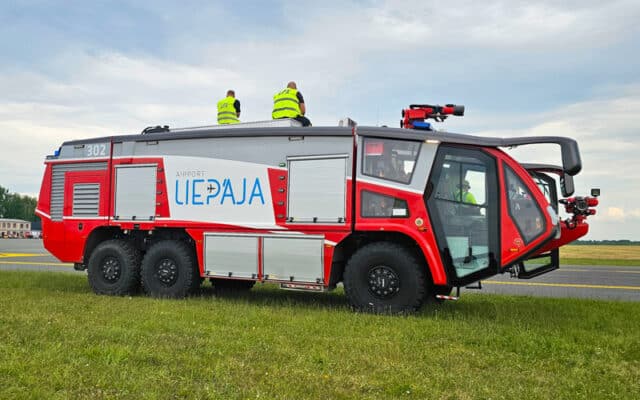
Meanwhile, a fire truck had parked on the apron and I’m pretty sure the guys on top had the best seat in the house. Liepāja Airfield has two fighter fighting trucks and one motorboat. I’m sure they were on standby for the entire show but it wasn’t immediately clear why they’d moved into position now.
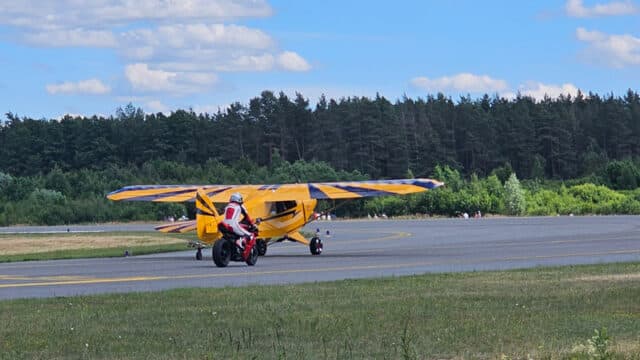
There was a lot of fuss about crazy Lithuanians but, in fairness to the southernmost Baltic country, it soon became clear that there were only two crazy Lithuanians, as the LY-CUB taxied out once again, accompanied by the same stunt driver, this time on a bright red Ducati motorcycle. The Italian manufacturing company has been making motorcycles since 1950 and they are now owned by Lamborghini (who is owned by Audi who is owned by the Volkswagen Group). I don’t know much about motorcycles but it was a beautiful and slick-looking piece of machinery.
As the Cub lined up at the mid-point of the runway, I thought for a moment that they were going to race. The Ducati can reach speeds of 200 km/hour while the Cub maxes out around 76 knots (87mph, 140 km/h), so the motorcycle certainly could beat the aircraft in a fair fight, by which I mean with a long enough runway and a net stretched over the top to keep the Cub from simply flying away.

But this wasn’t a race, fair or unfair. In a scene straight out of a Hollywood flick, the Cub came back around and flew low along the runway while the Ducati revved to catch it. As they sped along the runway, the motorcyclist reached out to spin a wheel on the side of the Cub.
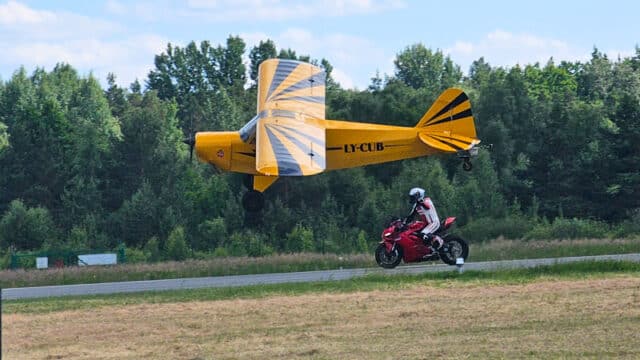
The concentration to maintain an exact speed while staying close to the Cub with one hand, reaching out with the other to spin the wheel was much more amazing than I feel the crowd gave them credit for. As the Cub flew away, the Ducati turned around and went back to the beginning of the runway, ready for another pass. This time, the motorcyclist lined up and clearly touched the wing, which was a bit more visible from the distance.

It was the third run that got them the most attention, as the motorcyclist reached out for the smoke machine at the back of the Cub. He got the smoke on and backed off as the Cub climbed away, just as a cloud of smoke appeared ready to envelop the motorcycle and its rider.
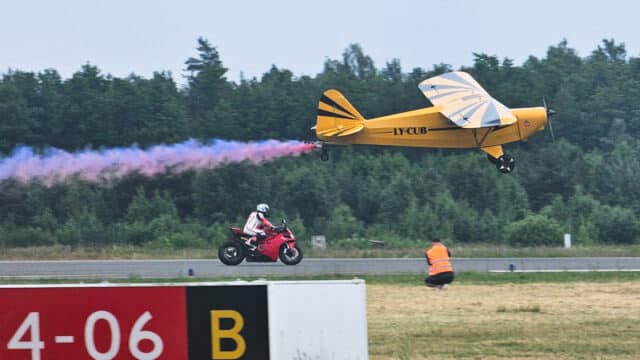
This time, the entire audience cheered as the Cub rose into the air emitting billows of pink and purple smoke.
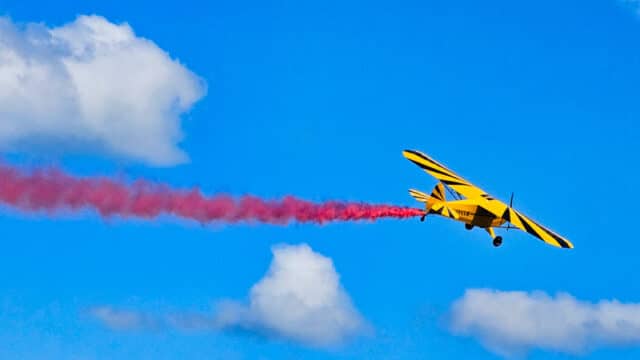
After it landed, the Cub and the Ducati both returned to the taxiway together. The poor motorcyclist had to be super careful not to end up knocked by the wing of the Cub as the pilot turned onto the taxiway. The Crazy Lithuanians got another round of applause before our attention turned to the final act.
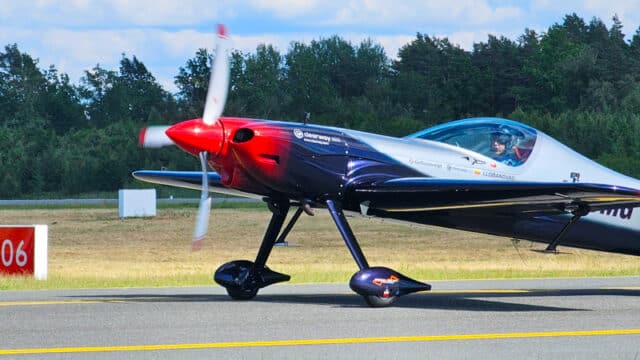
The XA-42 piloted by Igoris Lobanovas returned to the runway, this time alongside a Nissan and this time as they lined up, it became clear that it was a race. It wasn’t much of a race, as the XA-42, which cruises at 185 knots and has a max speed of 225 knots (417 km/h, 259 mph) quickly left the Nissan in the dust.
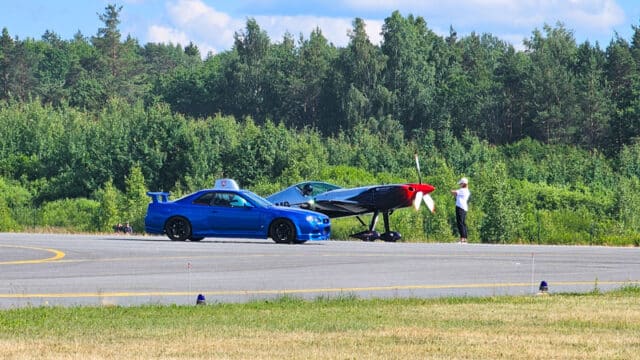
The German high-performance two-seater is designed to be dissembled quickly and easily for container transport but no more are being manufacturered. Able to withstand g-forces of +/- 10 g and a roll rate of 450º per second, Lobanovas was able to put it through its paces with rapid climbs and spins directly above the runway. On the Saturday, the X-42 performed alone and I struggled to keep the phone camera zoomed in tightly on the aircraft as it sped past in a low fly-by. A moment later, I realised I’d missed the best photograph entirely as coloured smoke swiftly rose up into the air from half a dozen spots in the grass in front of us, completely out of view of my shot.

Now the point of the fire engines was clear. Fireworks burst out following the coloured smoke while the X42 stayed clear, spinning from a fair height.
Of course, as I was attending both days, I was determined to get the shot on the second run-through.
This time, Aarron Delui and his Extra 330, by now crowned the winner of the weekend’s Air Master’s Cup challenge, joined Lobanovas for a dual aerobatic display.

They got into formation for a low pass over the grass together (in retrospect, actually over the runway, but it all happens so fast!) and this time I carefully framed the field along with the aircraft. I was so excited when I actually got the shot!
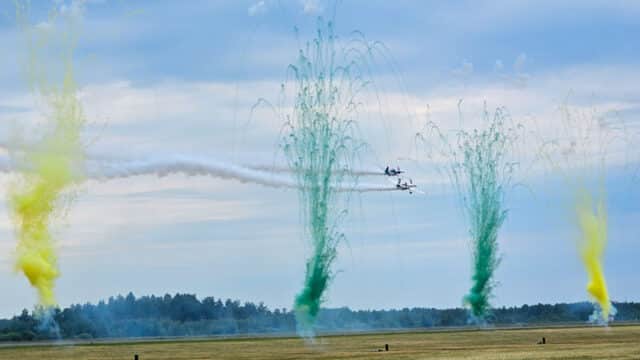
However, this time, possibly because the grass had dried out from the previous day, the firemen had to work for their prime position during the airshow. Black smoke appeared in an ominous ring over the airfield and flames appeared in the grass around the launchers. The firefighters dashed out to stomp out the flames. In less than a minute, all was well and the grass didn’t even show any scorch marks.
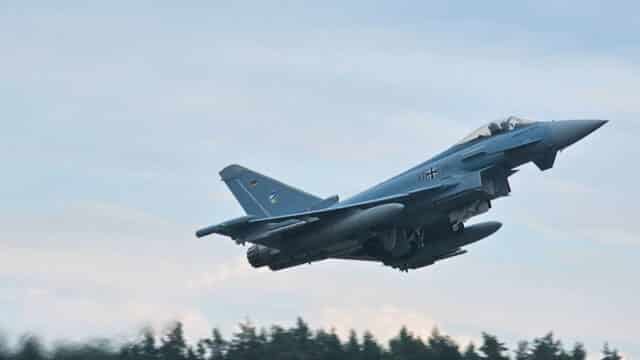
Although officially the show was officially over, the German Air Force Eurofighter, departing the airfield to return to base, decided to offer us a treat in the form of repeated fly-bys, at high speed and then close to stalling speed. Both were a delight to behold. Then the Eurofighter waggled its wings and disappeared into the distance. The Baltic International Air Show 2024 was over.
The two days had been so packed with activities, I barely even looked at the static airshow with various aircraft on display. My favourite was seeing kids climbing all over an Alca L-159 under the watchful but patient eyes of the Czech Air Force. What a fantastic opportunity!
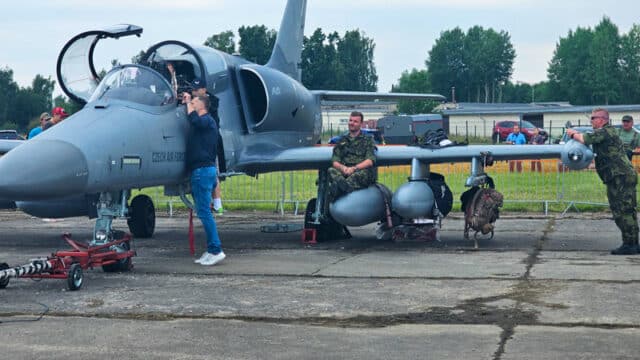
I want to thank everyone who was a part of the Baltic International Air Show, in particularly organiser Artūrs Šlosbergs, both for inviting me to attend but also for a fascinating event that in many ways outshone many a bigger air show with a bigger budget. Being up close and personal with the aircraft was amazing and I can only recommend that you find your way to Liepāja for the 2025 event!
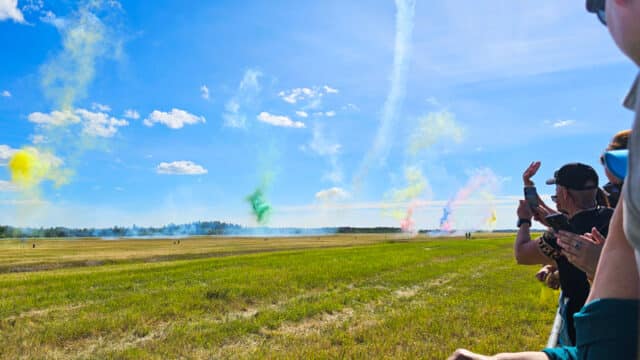








Just a quick point, the pictures labeled F-16s are actually Eurofighters
Shit, did I get my photos in the wrong order? Thanks — will do a quick fix now and replace them tomorrow.
(You know how some people get wordblind? I clearly got photography blind. I knew what the photograph was meant to be!)
It’s not that hard to do. I get it. I attended the 300,000 person Sun n Fun and shot 5k pics, and it’s so easy to grab the wrong one from a thumbnail. (Still haven’t finished editing lmao)
Welp, I’m looking at the photos now and I’m seeing canards and dual-exhausts everywhere. Thanks for the heads up.
Excellent; makes me wish that I’d been there.